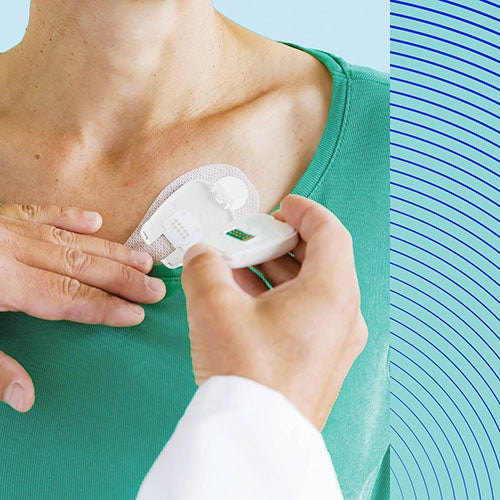Tech Tips
The Challenges of Skin as a Substrate

Pressure-sensitive adhesives have long been a staple in the health care industry. Think BAND-AID®*, medical tapes and electronic sensing equipment. The growing use of items such as medicine patches, as well as the anticipation of self-adhesive devices for personal health tracking, however, have created a surge for these types of applications. As such, it seems appropriate to have a discussion about human skin and the challenges of bonding to it.
Adhesives are commonly used to stick everything from a label onto a shampoo bottle, to a graphic onto a billboard, to a wound-care dressing to skin. The advantage of sticking shampoo labels and billboard graphics is that once the surface has been determined, it doesn’t vary, so selecting an adhesive to adhere the label or graphic is a relatively easy task. The adhesive must create a bond sufficient to do the job. This is driven by the surface to which the label or graphic will be applied as well as possible exposures (product contents, humidity, sunlight, etc.). The phrase “sufficient to do the job,” however, takes on a nebulous meaning when it comes to skin.
The surface of skin is not so easily defined as a polyethylene shampoo bottle or a billboard panel due to the infinite number of possible variations from person to person, and even different body parts on the same person. For example, the skin may be dry or damp, rough or smooth. It could be flaky, hairy, oily or sweaty. Furthermore, in addition to varying by individual, these factors can change seasonally or with physical activity.
Critical Success Factors
It would be simplistic to say, hairy skin is a rough texture; therefore, a more aggressive adhesive and/or a heavier coat weight may be the answer. But how much hair would be taken off upon removal of the bandage? Ouch!
Other challenges include contamination such as dead or flaky skin. Sticking to it is like trying to stick to something covered with dirt. The skin cells stick to the adhesive, but are partially or fully detached from the body, resulting in poor adhesion. Excretions such as oil and sweat interfere with bonding as well. When taken together, all these factors require balancing the aggressiveness of the adhesive to get the desired adhesion with the potential for pain upon removal. In striking this balance, however, what may hurt one person upon removal may not hurt another based on the delicateness of the patient’s skin (elderly/ neonatal) and the pain tolerance of the individual.
Finally, we have the question of compatibility. An adhesive that causes an allergic reaction, rash, or other irritation (which again varies from patient to patient) will not be a suitable choice. In fact, ISO 10993 provides specific requirements for skin contact adhesives relative to sensitization, irritation and cytotoxicity.
Back to Basics – Adhesion 101 As It Relates to Skin
With all this in mind, let’s look at the scientific aspects of skin adhesion.
- Surface Energy. For an adhesive to stick, it must be able to “wet” the surface (i.e. spread out over it evenly). When water beads up on a car, it is not wetting out because the car surface has a lower surface energy than the water. Similarly, for an adhesive to wet out, it must have a lower surface energy than the substrate to which it is being applied. The surface energy of skin, however, varies greatly. Dry, flaky skin has very high surface energy, while oily skin has very low surface energy. Add a little sweat, and now there’s a layer of water that the adhesive must get through to reach the skin.
- Compatibility. Like attracts like. The reason oil and water don’t mix is that oil is hydrophobic; it hates water. Cotton, on the other hand, is hydrophilic; it loves water. Skin is both. The amino acids in the skin are hydrophilic, but the oils in skin are hydrophobic. Creating an adhesive that “likes” both is a real challenge.
- Flexibility. Deformation, in this case caused by human movement, can affect adhesion. The rigidity of the bandage or device being applied plays a major role here. A flexible bandage will move with the skin and be less likely to peel or fall off, while a rigid sensor will not, requiring a more aggressive adhesive. Substrates such as vinyl and urethane are more flexible than polyester for example and, therefore, could allow for more movement and, in theory, extend the period of time a device will remain adhered.
Maximizing Adhesion While Minimizing the “Ouch” Factor
Adhesion to skin has been an ongoing challenge since the mid-1800s when Dr. Horace Day first combined India rubber, pine gum, turpentine, litharge, and cayenne pepper extract, and applied the mixture to strips of cloth to be used as surgical tape. Cayenne pepper?! That sounds like pain in a bottle just from the application of it, never mind the removal!
In balancing the aggressiveness of the adhesive with the potential for pain upon removal, surface energy and compatibility must be taken into account, as well as the flexibility and extensibility of the carrier. For example, the hydrophilicity of the adhesive can be adjusted to increase the bond, which may be necessary for rigid carriers such as sensors and drug delivery systems. Where ease of removability may be the dominant factor, such as with bandages or tapes being used on delicate skin, ensuring gentle removal will be a driving factor.
All of this, coupled with a plethora of variations in skin, makes it obvious why the development of skin contact adhesives keeps many scientists employed. If you’re seeking to break into this aspect of the health care market, knowing your Ps and Qs about skin adhesion will be essential to talking the talk with potential customers. It’s a lot more complex than choosing the cheapest product out there. Understanding the properties of each adhesive under consideration is necessary to ensure application success and client satisfaction.
The good news is that there are adhesives available that work. Acrylics tend to be the adhesives of choice because they are generally able to adhere without leaving a lot of residue or causing too much pain upon removal. For delicate or compromised skin, silicone adhesives are much gentler and are often chosen for use on neonatal and elderly patients where a more aggressive adhesive could damage the skin. The challenge is zeroing in on just the right one.
Check out our DermaFlex™ line of skin contact adhesives.
*BAND-AID is a registered trademark of Johnson & Johnson.

